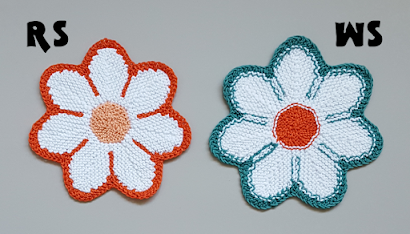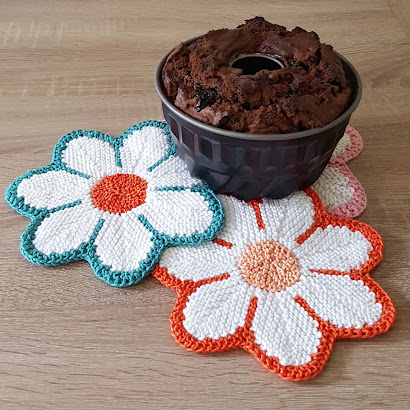Last year in April, I decided to use it to knit a cardigan - sideways and in one piece because I don't like cutting my yarn or and I like to minimize the finishing work (e.g. sewing pieces together). Plus, with variegated yarn, I don't like the abrupt color changes that can occur when putting on the arms.
In the end it took me to August 2019 to finish knitting it - and to the following January to finally sew up the arms and to attach the buttons. ... And now it's taken me nearly a year to write down the instructions. So, here's a tutorial on how to do something similar.
As with my other sweater patterns (e.g. Summer Garter Stitch Top and Waterfall Tunic) this is NOT a stitch-by-stitch pattern with stitch and row counts for various sizes but rather a tutorial on how to do something similar.
You will have to swatch and calculate for yourself. So this cardigan is completely configurable to your wishes and your shape. I will however give you my numbers and calculations as an example (written in purple).
The basic idea for stitch pattern (changing the skein and alternating between garter and stockinette stitch) is stolen from Lanesplitter Skirt by Tina Whitmore - because it is such great way to show off the color changes of the variegated yarn that I used.

This work by Kniting and so on is licensed under a Creative Commons Attribution-NonCommercial-NoDerivatives 4.0 International License.

- yarn, I used about 470 grams of Aran Weight yarn (Noro Furin, colorway 4 - here's a link to the yarn's Ravelry page),
- straight or circular knitting needles, I used 4.5mm needles - mine were 100 cm long.
- removable stitch markers (safety pins or scrap yarn work fine as well)
- 3 buttons, and sewing needle and thread to sew them on
Techniques
- Short rows with wrap and turn (w+t) - as shown in this YouTube video by Very Pink Knits. (Yes, other short row methods works as well.)
- Knitted Cast-On: See this Youtube-video by Very Pink Knits.
- Cable Cast-On: See this Youtube-video by Very Pink Knits.
- Pick up and knit: Picking up stitches from the side edge of your work as shown in this YouTube video by B.Hooked Crochet & Knitting
Construction, Measurements, and Calculations
The cardigan is knitted sideways and in one piece. It starts with the left sleeve is knitted up to the shoulder. Then (with knitted COs on both sides) the piece is widened to create the front and back piece of the cardigan). At each end short rows are used to shape the piece (i.e. to make sure it is wide enough to fit around your waist). When you've reached the width of your shoulder, you bind off the stitches on the front part and start to knit a "back-only" part. This starts with a few decreases at the top to get a round neckline at the neck edge.
 |
| Figure 1: Construction |
B = arm circumference at shoulder
C = from shoulder to hip (total length of garment)
D = from under arm to hip (or C-B/2)
E = depth of neckline on the back of the garment
G = width of shoulder seam
H = half of the width of neckline
I = width of one side of the cardigan at your hip (for me H=I/2)
J = width at hip (should be roughly half of your hip circumference)
 |
| Figure 2: Measurements |
Knit a swatch and calculate the stitch and row numbers according to your measurements!
Alternatively, with a rough idea of your gauge, you can start with the arm piece and use this as your swatch - however, this swatch piece has then not been blocked and/or washed and might be less exact than you'd like it to be ... and maybe you'll need to frog it after knitting half a sleeve (i.e. you've just knitted a bigger swatch ;-(.
So, better just knit a swatch and block it.
Here are my calculations for stitch numbers and ridges - rounded. My swatch measured 18 sts for 10 cm in width and 30 rows (in pattern) for 10 cm in height.
A = 22 cm = 40 sts
B = 42 cm = 72 sts
C = 60 cm = 108 sts
D = 60 cm - 21 cm = 39 cm - or 108 sts - 36 sts = 72 sts
E = 1,5 cm = 3 sts
F = 45 cm = 135 rows
G = 10 cm = 30 rows
H = 10 cm = 30 rows
I = 25 cm = 75 rows
J = 50 cm = 150 rows
- The 2nd half of one piece (right side) is the exact mirror of the 1st part (left side). So it's essential to take notes while you're knitting, in order to be able to knit the same rows in the opposite order (i.e. decreases where you increased, BO where you CO'd etc.)
- Since I am not "busty" I didn't make allowance for bust shaping. This can be done by starting the front side short rows higher up in the rows or by inserting short rows at bust height that act as bust darts (as I did in the No Assembly Required Top).
The basic stitch pattern for the sleeves (without the calculated increases) is:
- two rows in stockinette stitch in S1,
- two rows in garter stitch (i.e. one garter ridge) in S2,
- four rows in stockinette stitch in S1,
- two rows in garter stitch (i.e. one garter ridge) in S2.
Row 2 (WS, S1): sl1, p to end // stockinette part, S1
Row 3 (RS), S2): sl1, k to end
Row 4 (WS, S2): sl1, k to end // garter ridge, S2
Row 5 (RS, S1): sl1, k to end
Row 6 (WS, S1): sl1, p to end
Row 7 (RS, S1): sl1, k to end
Row 8 (WS, S1): sl1, p to end // stockinette part, S1
Row 9 (RS), S2): sl1, k to end
Row 10 (WS, S2): sl1, k to end // garter ridge, S2
- two rows in stockinette stitch in S1 - with some (calculated) short rows at the beginning and end of the row
- two rows in garter stitch (i.e. one garter ridge) in S2
CO A stitches with S1
Instead of ribbing, knit several rigdes of garter stitch, alternating the skeins after each ridge.
I did a CO of 46 stitches and knit 4 ridges in garter stitch.
Body (Back Piece and Two Front Pieces)
Left Half
I wanted to add 39 cm to the lenght (added to the sleeve width - back and front), so I CO'd 72 sts on each side.
Since you're knitting sideways and the shoulders are narrower than the piece around the hips, you now have to calculate the amount of short rows to knit at the front and the back. Plus, you have to decide where you want your short rows to end.
The short rows for the front piece are calculated by the ratio of G to I (i.e. shoulder width to width at the hip of one half).
And the short rows for the back piece by the ratio of G+H to J/2 (i.e. shoulder width plus half of the neckline width to half of the width at the hip.
Row 2 (WS, S2): sl1, k to end // garter stitch ridge
Row 3 (RS), S1): sl1, k to end
Row 4 (WS, S1): sl1, p65, w+t
Row 2 (WS, S2): sl1, k to end // garter stitch ridge
Row 3 (RS), S1): sl1, k to end
- you increase where you decreased before,
- you to a BO where you did a CO before (and vice versa),
- you knit the same short rows as before - just in reverse order.
Row 12 (WS, S2): sl1, k to end // garter ridge
Row 22 (WS, S2): sl1, k to end // garter ridge
The right sleeve is the left sleeve knitted backwards, i.e. knitting the stitch pattern in reverse order and doing decreases where you did increases before.
Row 2 (WS, S2): sl1, k to end // garter ridge
Row 4 (WS, S1): sl1, p to end
Row 5 (RS, S1): sl1, k to end
Row 6 (WS, S1): sl1, p to end // stockinette part
Row 8 (WS, S2): sl1, k to end // garter ridge
Row 10 (WS, S1): sl1, p to end // stockinette part
Collar
Pick up stitches all along the inner edge on the left front, the neck and the right edge in front (see green line in figure 1 above).
































